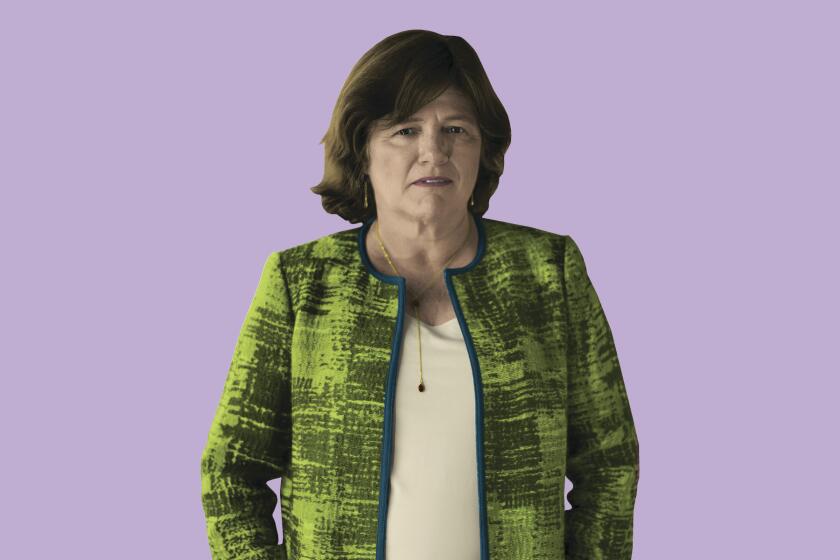Welcome to Unshaken: Are you ready for a big earthquake?

- Share via
Here’s the thing about an earthquake: When you think it’s over, it’s not over — not by a long shot.
Winston Churchill once said, “Nothing in life is so exhilarating as to feel an earthquake without result.”
Get earthquake-ready in six weeks
From building a kit to buying insurance, our Unshaken newsletter course will help you prepare.
You may occasionally receive promotional content from the Los Angeles Times.
All right, that’s not precisely what he said. What he actually described was the exhilaration of “being shot at without result.” But the sensation must be pretty much the same: first, that survival urge when you feel the quake take hold and shake; then that adrenaline surge when it stops, and you’re still standing, and your brain high-fives you and hollers, “We made it, yo!”
Then what?
That’s what this newsletter course is about, getting you ready for your closeup in Southern California’s seismic story.
Some cultures tell their war stories. We tell earthquake stories. We tell them in movies — in “L.A. Story,” where Angelenos keep noshing away at brunch through a quake that rattles the glassware, and Steve Martin, with sang-froid, figures it at about a 4.0. In “Earthquake,” with Charlton Heston gritting his teeth through a 9.9-er. In “San Francisco,” with gambler Clark Gable getting religion and the girl after the 1906 quake. And in “San Andreas,” when helicopter rescue pilot Dwayne Johnson maneuvers his bird through the video-game chaos of not one but two 9-plus quakes to rescue his womenfolk.
I think the niftiest thing about “San Andreas” was that Lucy Jones, the renowned seismologist, was live-tweeting through the 2015 premiere, aghast at some of the alarmist absurdity of it:
“If seismologists could actually predict EQs, we’d all be much richer. Too bad that part of ‘San Andreas’ isn’t real. ... Now people fall trying to run but they run anyway. I guess only the seismologists know Drop Cover Hold On. … OMG! A chasm? If the fault could open up, there’d be no friction. With no friction, there’d be no earthquake. … Tsunami from San Andreas [fault] is impossible. Now we are in fantasy territory. … Bottom line: don’t learn seismology from #SanAndreas but maybe it will inspire people to take Community Emergency Response Training.”
It couldn’t be clearer. When it comes to earthquakes, Jones could save more lives with tweets than Johnson could with a fleet of Bell 412 helicopters.
Saving your life, your family’s lives, your home — that’s what you’ll be reading in Unshaken: making sure your water heater is strapped to the wall; checking that your house is bolted to the foundation; assembling your quake kit. Unless you have a helipad out back, this advice is your best bet for making it through not just the adrenaline kick but the wallop that follows, the one that can derail lives.

Every earthquake teaches us to do things differently. The 1933 Long Beach quake happened at 5:54 p.m. on Friday, March 10. The school day had mercifully ended a few hours before; the sight of the schoolhouse rubble that could have entombed children scared California into mandating building codes.
Things were pretty freewheeling before then, and early photos of earthquake damage — well before 1933 — gave us one of the most ineradicable myths of quake safety. People saw photographs of old buildings shaken to bits, and the only thing left standing was a doorway. And so they thought, Aha! Run to a doorway when the shaking starts! The problem: Those tumbledown buildings were unreinforced masonry, like adobe, and sometimes the wood-framed doorways did stand — but they were hardly safe. A doorway will not protect you. Hiding under a sturdy table or desk could.
Some earthquake or another may have taught you your own lesson.
1971 Sylmar quake: Don’t put a bookshelf over the head of the bed.
1987 Whittier Narrows quake: Keep an earthquake kit in the car. I was covering the king of Spain’s visit to L.A. during that quake (more on him later) and realized that a couple of bottles of water and some traffic flares were not enough. The prep box now in my car is large, true, but I could probably camp out for three days with what’s in it, which includes dessert.

1994 Northridge quake: Frame posters with plastic, not glass.
I’ve also kept my landline — a real landline, not the digital so-called landlines they’re peddling now — because those phones work after a quake, when your cellphone might not. And keep some cash handy; electronic payment devices might be knocked out.
Here are some earthquake insights and lessons from famous people.
Joan Didion, California native and prose goddess, to The Times in 2005: “I am sort of religious. But I don’t believe in a personal god. I believe in geology. You can’t be in an earthquake … without believing in that. It’s pretty awe-inspiring. It’s not personal.”
Actress Helen Hunt, in “The Guardian” in 2008, about keeping her Oscar on a shelf above her desk: “So if there’s another earthquake in California I’ll be killed by my own Academy Award.”
Actress Alyssa Milano: “I used to sleep nude — until the earthquake.” While this is a very sensible lesson — and it extends to keeping sturdy shoes next to your bed — I have no idea which earthquake precipitated her pajama epiphany. The quote appeared in 2004 in a supermarket tabloid whose cover story was “Dick Cheney Is a Robot,” so judge for yourself.
Father Juan Crespi, part of the Portola expedition, writing with nonchalance on Aug. 1, 1769: “At ten in the morning the earth trembled. The shock was repeated with violence at one in the afternoon, and one hour afterwards we experienced another. The soldiers went out this afternoon to hunt, and brought an antelope ... it was not bad.”
Hamlet, prince of Denmark: “The readiness is all.”
People are much more important than kits. People will help each other when the power is out or they are thirsty. And people will help a community rebuild and keep Southern California a place we all want to live after a major quake.
That brings us back to royalty. The king of Spain was expecting Oct. 1, 1987, to be a red-letter day, and so it was — not only because he would be the first Spanish monarch to visit a synagogue in at least 500 years, but because of the Whittier Narrows quake.
The 5.9 quake rippled like “a trembling arpeggio,” I wrote, through the penthouse of the Century Plaza, but the king assured an aide that the hotel was “built for a 7.” (More discreetly, I was told, the king reacted with a curt English expletive when the top of the 30-story hotel started doing the bend and snap.)
Oh, one more part of your quake preparations: Be ready for people from colder, uglier, more dispirited states to tell you to get the hell out of this crazy place and move, usually to states with tornadoes, blizzards and floods.
And you might decide to do just that. It happens; no one here will blame you for not getting back on the horse that threw you. And so you move someplace else, maybe seismically comatose Florida. Where they have hurricanes and sinkholes that can swallow up half a city block. Just like a disaster movie.
Japan has a sophisticated system to alert its residents, and Mexico City has ubiquitous sirens. Is California’s early warning system ready?
But if you would rather stay — and we wish you would — this newsletter is how you stay ready and resilient. In a word, unshaken.
Sign up to get Unshaken, the L.A. Times’ newsletter guide to earthquake readiness and resilience, in your inbox on Fridays. Your first assignment will be to get a kit together of the supplies and equipment you’ll need around your home. We’ll walk you through it.
Get earthquake-ready in six weeks
From building a kit to buying insurance, our Unshaken newsletter course will help you prepare.
You may occasionally receive promotional content from the Los Angeles Times.










